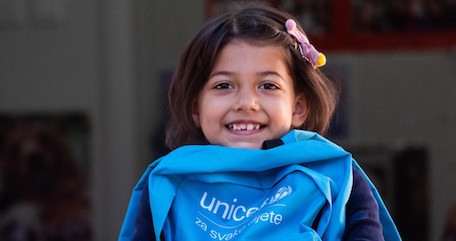As COVID-19 cases spike again all over the world, fuelled by the highly transmissible Omicron variant, parents, teachers and students are grappling with school closures.
“One thing we do know for certain: Another wave of widespread school closures would be disastrous for children,” UNICEF Executive Director Henrietta Fore warned on December 17.
“The evidence is clear: Prolonged, nationwide school closures; limited resources for students, teachers and parents; and lack of access to remote learning have wiped out decades of progress in education and rendered childhood unrecognizable. A shadow pandemic of child labor, child marriage and mental health issues has taken hold.”
Prolonged, nationwide school closures have already wiped out decades of progress in education
Some students have been able to access remote learning during school closures, but many of them have struggled due to a lack of support. At least one-third of the world’s schoolchildren had no access to remote learning at all.
Outcomes from online school are not the same as in-person outcomes. A McKinsey report examining the effects of COVID-19 on the 2020-21 school year in the U.S. found that the pandemic left students five months behind in math and four months behind in reading. For schools with majority Black and brown populations, the losses were even greater: six months behind in math and five to six in reading. One million U.S. students didn’t show up in-person or online at all. Young children and students from families living below the federal poverty line were the most likely to miss out on school completely.
Boys and girls celebrate their return to school with coloring books and masks at Chiguatillo Fiscal School, Playa Grande Community, Esmeraldas, Ecuador in September 2021. © UNICEF/UN0518076/Pintado
In-person school provides students with safety, daily interactions with friends, access to health care and, too often, the only nutritious meal of the day
The benefits of in-person school extend beyond classroom instruction. “Beyond lost learning, children have also lost the safety of school, daily in-person interactions with friends, access to health care, and, too often, their only nutritious meal of the day,” Fore said. “This generation of schoolchildren could collectively lose US$ 17 trillion in potential lifetime earnings.
“That is why nationwide school closures should be avoided whenever possible. When COVID-19 community transmission increases and stringent public health measures become a necessity, schools must be the last places to close and the first to reopen.”
A group portrait of students wearing masks at Gandaria Mohila Shomity Government Primary School, Dhaka, Bangladesh on September 12, 2021. © UNICEF/UN0527661/Sujan
The right to go to school and learn is central to every child’s development. Keeping kids in school must be a global priority. Here are three reasons why:
- School closures deepen an existing learning crisis — the longer schools are shut, the more students fall behind in their learning. Basic reading and math skills are already in sharp decline among the most vulnerable students.
- Education is a powerful tool to fight poverty. Children with less schooling are more likely to live in poverty for the rest of their lives. And their children too.
- School closures are affecting the mental health of an entire generation of children. It’s unacceptable for bars, restaurants and gyms to be open while schools remain closed. Children need to be in school now.
2022 cannot be yet another year of disrupted learning. It needs to be the year that education, and the best interests of children, take precedence. — UNICEF Executive Director Henrietta Fore
“We know that mitigation measures in schools are effective,” said Fore. “We must use this knowledge to do everything we can to keep schools open. We must also increase investments in digital technology to make sure no child is left behind. 2022 cannot be yet another year of disrupted learning. It needs to be the year that education, and the best interests of children, take precedence.”
UNICEF is working across 190 countries and territories to ensure children receive the education they need to each their full potential. You can help.
Top photo: Six-year-old Asal, whose family left Afghanistan when she was 4, eagerly began her first day of formal education with other children staying in a temporary reception center for migrants and refugees in Sarajevo, Bosnia and Herzegovina in October 2021. “I am happy to go to school today. I like drawing the most. My mother taught me English, and now I will learn Bosnian,” she said, hugging her new UNICEF backpack full of school supplies. © UNICEF/UN0535351/Djemidzi
